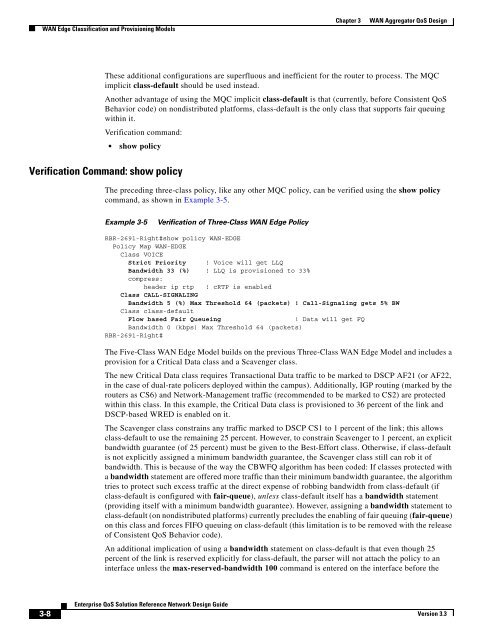Enterprise QoS Solution Reference Network Design Guide
Enterprise QoS Solution Reference Network Design Guide
Enterprise QoS Solution Reference Network Design Guide
You also want an ePaper? Increase the reach of your titles
YUMPU automatically turns print PDFs into web optimized ePapers that Google loves.
WAN Edge Classification and Provisioning Models<br />
3-8<br />
<strong>Enterprise</strong> <strong>QoS</strong> <strong>Solution</strong> <strong>Reference</strong> <strong>Network</strong> <strong>Design</strong> <strong>Guide</strong><br />
Chapter 3 WAN Aggregator <strong>QoS</strong> <strong>Design</strong><br />
These additional configurations are superfluous and inefficient for the router to process. The MQC<br />
implicit class-default should be used instead.<br />
Another advantage of using the MQC implicit class-default is that (currently, before Consistent <strong>QoS</strong><br />
Behavior code) on nondistributed platforms, class-default is the only class that supports fair queuing<br />
within it.<br />
Verification command:<br />
show policy<br />
Verification Command: show policy<br />
The preceding three-class policy, like any other MQC policy, can be verified using the show policy<br />
command, as shown in Example 3-5.<br />
Example 3-5 Verification of Three-Class WAN Edge Policy<br />
RBR-2691-Right#show policy WAN-EDGE<br />
Policy Map WAN-EDGE<br />
Class VOICE<br />
Strict Priority ! Voice will get LLQ<br />
Bandwidth 33 (%) ! LLQ is provisioned to 33%<br />
compress:<br />
header ip rtp ! cRTP is enabled<br />
Class CALL-SIGNALING<br />
Bandwidth 5 (%) Max Threshold 64 (packets) ! Call-Signaling gets 5% BW<br />
Class class-default<br />
Flow based Fair Queueing ! Data will get FQ<br />
Bandwidth 0 (kbps) Max Threshold 64 (packets)<br />
RBR-2691-Right#<br />
The Five-Class WAN Edge Model builds on the previous Three-Class WAN Edge Model and includes a<br />
provision for a Critical Data class and a Scavenger class.<br />
The new Critical Data class requires Transactional Data traffic to be marked to DSCP AF21 (or AF22,<br />
in the case of dual-rate policers deployed within the campus). Additionally, IGP routing (marked by the<br />
routers as CS6) and <strong>Network</strong>-Management traffic (recommended to be marked to CS2) are protected<br />
within this class. In this example, the Critical Data class is provisioned to 36 percent of the link and<br />
DSCP-based WRED is enabled on it.<br />
The Scavenger class constrains any traffic marked to DSCP CS1 to 1 percent of the link; this allows<br />
class-default to use the remaining 25 percent. However, to constrain Scavenger to 1 percent, an explicit<br />
bandwidth guarantee (of 25 percent) must be given to the Best-Effort class. Otherwise, if class-default<br />
is not explicitly assigned a minimum bandwidth guarantee, the Scavenger class still can rob it of<br />
bandwidth. This is because of the way the CBWFQ algorithm has been coded: If classes protected with<br />
a bandwidth statement are offered more traffic than their minimum bandwidth guarantee, the algorithm<br />
tries to protect such excess traffic at the direct expense of robbing bandwidth from class-default (if<br />
class-default is configured with fair-queue), unless class-default itself has a bandwidth statement<br />
(providing itself with a minimum bandwidth guarantee). However, assigning a bandwidth statement to<br />
class-default (on nondistributed platforms) currently precludes the enabling of fair queuing (fair-queue)<br />
on this class and forces FIFO queuing on class-default (this limitation is to be removed with the release<br />
of Consistent <strong>QoS</strong> Behavior code).<br />
An additional implication of using a bandwidth statement on class-default is that even though 25<br />
percent of the link is reserved explicitly for class-default, the parser will not attach the policy to an<br />
interface unless the max-reserved-bandwidth 100 command is entered on the interface before the<br />
Version 3.3
















